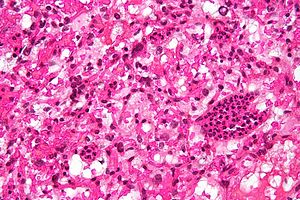Haemangioblastoma
| Hemangioblastoma | |
|---|---|
 |
|
| Micrograph of a cerebellar hemangioblastoma. HPS stain. | |
| Classification and external resources | |
| ICD-10 | D48.1 |
| ICD-O | M9161/1 |
| DiseasesDB | 31512 |
| eMedicine | med/2991 radio/326 |
| MeSH | D018325 |
Hemangioblastomas (or haemangioblastomas, see spelling differences) (capilliary hemangioblastomas) are tumors of the central nervous system that originate from the vascular system usually during middle-age. Sometimes these tumors occur in other sites such as the spinal cord and retina. They may be associated with other diseases such as polycythemia (increased blood cell count), pancreatic cysts and Von Hippel-Lindau syndrome (VHL syndrome). Hemangioblastomas are most commonly composed of stromal cells in small blood vessels and usually occur in the cerebellum, brain stem or spinal cord. They are classed as grade one tumors under the World Health Organization's classification system.
Hemangioblastomas are composed of endothelial cells, pericytes and stromal cells. In VHL syndrome the von Hippel-Lindau protein (pVHL) is dysfunctional, usually due to mutation and/or gene silencing. In normal circumstances, pVHL is involved in the inhibition of hypoxia-inducible factor 1 α (HIF-1α) by ubiquitin mediated proteosomal degradation. In these dysfunctional cells pVHL cannot degrade HIF-1α, causing it to accumulate. HIF-1α causes the production of vascular endothelial growth factor, platelet derived growth factor B, erythropoietin and transforming growth factor alpha, which act to stimulate growth of cells within the tumor.
...
Wikipedia
